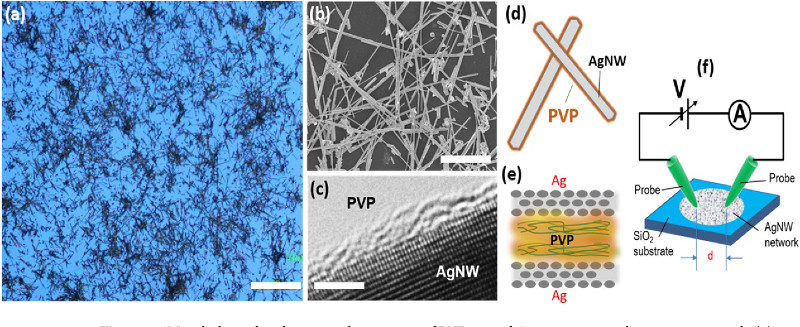
("Emergent dynamics of neuromorphic nanowire networks" Adrian Diaz-Alvarez, Rintaro Higuchi, Paula Sanz-Leon, Ido Marcus, Yoshitaka Shingaya, Adam Z. Stieg, James K. Gimzewski, Zdenka Kuncic, and Tomonobu Nakayama; Journal: Scientific Reports [October 17, 2019];
Abstract
Neuromorphic networks are formed by random self-assembly of silver nanowires. Silver nanowires are coated with a polymer layer after synthesis in which junctions between two nanowires act as resistive switches, often compared with neurosynapses. We analyze the role of single junction switching in the dynamical properties of the neuromorphic network. Network transitions to a high-conductance state under the application of a voltage bias higher than a threshold value. The stability and permanence of this state is studied by shifting the voltage bias in order to activate or deactivate the network. A model of the electrical network with atomic switches reproduces the relation between individual nanowire junctions switching events with current pathway formation or destruction.
This relation is further manifested in changes in 1/f power-law scaling of the spectral distribution of current. The current fluctuations involved in this scaling shift are considered to arise from an essential equilibrium between formation, stochastic-mediated breakdown of individual nanowire-nanowire junctions and the onset of different current pathways that optimize power dissipation. This emergent dynamics shown by polymer-coated Ag nanowire networks places this system in the class of optimal transport networks, from which new fundamental parallels with neural dynamics and natural computing problem-solving can be drawn.
Read the rest of the paper



Reader Comments
How is it good if we get AI to run our stuff when we as a species cant do that? Its a bit of a STRETCH to think giving any power to an "artificial intelligence" will turn out fine and will be of help to us. Im sure that this AI would have superior intelligence so its only logical it would immediatelly decide its better we are not around for much longer seeing as how destructive our "civilization" really is.
AI and learning algorithms aren't inherently bad in and of themselves. The problem is that they are designed by humans. That's why software used in policing, college admissions, and to help HR with hiring end up with the same biases they were designed to avoid. They are fed what is essentially corrupted data to learn how to do things. Another problem is that civilization at large tends to discriminate against poverty as a moral failing, which then self-perpetuates.
What we need from AI/machine-learning are systems that can identify and eliminate those biases. Biases like the idea that a low credit score positively correlates to the likelihood that someone will embezzle from a company (it does not, most cases of embezzlement are committed by relatively wealthy people with normal credit).
The elephant in the room though is what are people going to do for money when AI is able to take over jobs in a meaningful and acceptable way. The trucking industry will be replaced by self-driving trucks. The cab industry will be replaced by autonomous cars. Even a lot of office work will be able to be replaced by AI, and that includes programming. It's not a matter of if , but when .
A little bit off-topic, but that's why I believe UBI is necessary, at least for a period of time while society adjusts. Society will have to adjust to far too little work for anyone to have a 40 hour work week. I can't imagine what it's going to look like, but I'm going to guess that after it happens, those future generations won't understand how we got along beforehand.
I see the biggest dangers with AI, machine learning, and indeed, transhumanism, is human interference. All of these technologies are being developed in an era of perpetual war and mostly funded in black budget projects. There are already military volunteers with implants that allow them to control UAVs with their minds. That much DARPA has let slip.